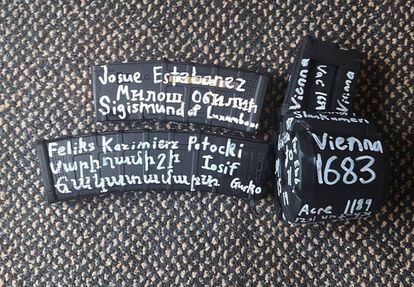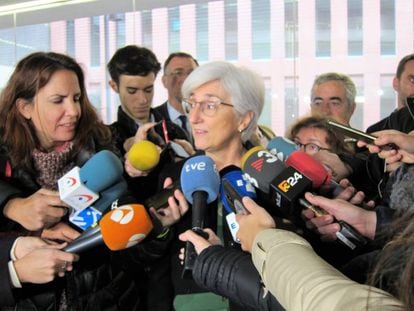How a Spanish neo-Nazi became an international ‘hero’ of the far right
Josué Estébanez is considered a cult figure by extremists, including the New Zealand mosque shooter, for killing a left-wing activist on the Madrid subway in 2007

On November 11, 2007, Josué Estébanez killed a 16-year-old left-wing activist named Carlos Palomino on a Metro train in Madrid. More than a decade later, Estébanez has become a cult figure for white supremacists across the world, including Brenton Tarrant, the terrorist who killed 50 people at two mosques in New Zealand. Tarrant had written Estébanez’s name on his rifle magazine, along with the names of far-right figures responsible for mass murders in other countries.
New Zealand mosque shooter Brenton Tarrant traveled to Spain in 2018
In English- and Spanish-language forums, on underground websites and social media sites, Estébanez is revered as an “idol,” with users from the Netherlands, Ukraine and Australia paying their “respects” to the neo-Nazi.
Estébanez’s fame largely stems from the fact that there is a four-minute 20-second video of his crime. Security cameras show how the then-25-year-old former soldier pulled out a 25-centimeter knife when he saw a group of left-wing activists waiting to board at the next platform. Estébanez was on his way to an anti-immigration demonstration organized by the far-right group National Democracy (DN). Palomino and his friends were planning to join the counter-demonstration.

In the video, Palomino boards the train and approaches Estébanez, grabbing the neo-Nazi’s Three Stroke sweatshirt, a brand associated with the far right. In one quick movement, Estébanez stabs Palomino in the heart. The 16-year-old died minutes later outside Legazpi Metro station. Estébanez was sentenced to 26 years in prison in a case that, for the first time in the Spanish justice system, recognized ideological reasons as an aggravating factor in the crime.
Online radicalization
Initially, the murder of Palomino only received coverage in Spanish media but it was quickly celebrated by white supremacists across the world thanks to the internet. Estébanez began to build cult status after he gained attention on xenophobic online forums such as Stormfront. Some users called for donations for Estébanez, while others asked forum members to send supportive letters to his prison cell.
“Everyone wants to know why more violent acts of this type are happening, and one of the factors that could be motivating them is the internet,” says Peter Langman, a psychologist from the United States.
This no longer a local issue, it has become inspiration for radicals across the world
Researcher Jacob Davey
On the sixth anniversary of the murder, the white supremacist website The Daily Stormer – a reference to Adolf Hitler’s favorite tabloid Der Stürmer – published an article by Alfred Heisenberg describing Estébanez as a “brave soldier” who was cornered by “red terrorists.” “I can’t imagine the adrenaline that must have flooded through the body of this hero when the train doors opened and he was surrounded by the crowd,” the article read.
A video uploaded to YouTube also celebrates the fact that Estébanez acted alone. Under the English title “50 AFA [anti-fascists] versus one nationalist in Spain,” the clip replays the killing with video game music. Other YouTube videos from various countries call for Estébanez to be released from prison
Just seven months ago, the neo-Nazi group The Nordic Resistance Movement described Estébanez as “a champion” in a podcast. The program was shared with the hashtags #estebanez and #libertad (freedom).
The researcher Jacob Davey says that ideologically driven hate crimes such as the murder of Palomino have widespread repercussions. “This is no longer a local issue, it has become inspiration for radicals across the world,” explains Davey, who works for ISD, a London-based organization that monitors hate crimes online.
Neo-Nazis in Spain
The DN party, which organized the anti-immigration march Estébanez was planning on attending, launched a Spain-wide campaign in his support after he was sent to prison. Dubbed “Fair trial for Josué,” the campaign had little impact on the ground but years later it continues to be mentioned in radical online forums. “[Estébanez] is going to serve 26 years for defending himself from a communist attack. He felt an irrational fear and that is what made him act that way,” says party president Pedro Chaparro.
Esteban Ibarra, the president of the Movement against Intolerance, believes that Spain is home to small but very active groups of neo-Nazis with very radical ideas. For instance, Anders Behring Breivik, the terrorist behind the 2011 attacks in Norway, had in-depth knowledge about the Spanish far right, which he demonstrated in a manifesto he wrote before the attack.
“There is a network that connects online. Apparently they are lone wolves but they are in contact with the rest in secret forums. There is an ideological connection and they travel a lot,” says Ibarra, who has spent 25 years studying and reporting on far-right groups.
The mosque shooter Tarrant traveled to Spain in 2018 and visited eight provinces. Police are now investigating what he did during those days and who he visited. There are suggestions that it was on this trip that he learned about Estébanez.
Risk of copycats
Authorities and experts are concerned that growing online radicalization could lead to copycat crimes. According to the psychologist Langman, the Columbine High School massacre in 1999 was explicitly mentioned as an influence in 30 school shootings inside and outside the United States.
But stopping the spread of extremist content online is proving a big challenge for authorities, the media and internet providers. Mosque shooter Tarrant, for instance, was apparently radicalized in internet forums like the English-language 8chan, where hate speech is freely spewed without moderation. The owner of the forum, Jim Watkins, a US businessman who lives in the Philippines where he raises pigs, has defended the lack of moderation in interviews on the grounds of "freedom of expression."
Tarrant filmed the shooting at the two mosques on a GoPro camera and streamed the video on Facebook Live. Social media monitoring teams have worked to eliminate the video from all networks. According to Facebook, it deleted 1.5 million videos related to the killing in the first 24 hours.
English version by Melissa Kitson.












































